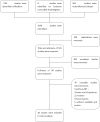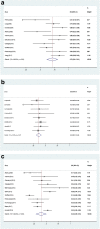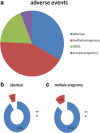Assisted reproductive techniques with congenital hypogonadotropic hypogonadism patients: a systematic review and meta-analysis
- PMID: 30453944
- PMCID: PMC6245556
- DOI: 10.1186/s12902-018-0313-8
Assisted reproductive techniques with congenital hypogonadotropic hypogonadism patients: a systematic review and meta-analysis
Abstract
Background: After hormonal replacement therapy (HRT) including androgen replacement or sequential therapy of estrogen and progesterone, The combination of human chorionic gonadotropin (hCG) and human menopausal gonadotropin (hMG) and pulsatile GnRH, is not sufficient to produce sufficient gametes in some patients with Congenital hypogonadotropic hypogonadism (CHH). A Systematic review and meta-analysis was performed to determine that assisted reproductive techniques (ART) can effectively treat different causes of infertility.
Methods: To determine the effect of ART on fertility of CHH patients and investigate whether outcomes are similar to infertility due to other causes, we conducted a systematic review and meta-analysis of retrospective trials. Clinical trials were systematically searched in Medline, Embase, and the Cochrane central register of controlled trials databases. The keywords and major terms covered "hypogonadotropic hypogonadism", "kallmann syndrome", "assisted reproductive techniques", "intrauterine insemination", "intracytoplasmic sperm injection", "testicular sperm extraction", "in vitro fertilization", "embryo transplantation" and "intra-Fallopian transfer".
Results: A total of 388 pregnancies occurred among 709 CHH patients who received ART (effectiveness 46, 95% confidence interval 0.39 to 0.53) in the 20 studies we included. The I2 in trials assessing overall pregnancy rate (PR) per embryo transfer (ET) cycle was 73.06%. Similar results were observed in subgroup analysis by different gender. Regression indicates pregnancy rate decreases with increasing age. Fertilization, implantation and live birth rates (72, 36 and 40%) showed no significant differences as compared to infertility due to other causes.
Conclusions: Despite CHH patients usually being difficult to generate gametes, their actual chances of fertility are similar to subjects with other non-obstructive infertility. ART is a suitable option for CHH patients who do not conceive after long-term gonadotropin treatment.
Keywords: Assisted reproductive techniques; Congenital hypogonadotropic hypogonadism; Fertility; Hormonal replacement therapy.
Conflict of interest statement
Ethics approval and consent to participate
All analyses were based on previous published studies, thus no ethical approval and patient consent are required according to the regulation of Peking Union Medical College Hospital ethic committee. All previous published studies were approved by ethics committee respectively.
Consent for publication
Not applicable.
Competing interests
The authors declare that they have no competing interests.
Publisher’s Note
Springer Nature remains neutral with regard to jurisdictional claims in published maps and institutional affiliations.
Figures






References
Publication types
MeSH terms
Substances
Grants and funding
LinkOut - more resources
Full Text Sources
Medical
Research Materials

